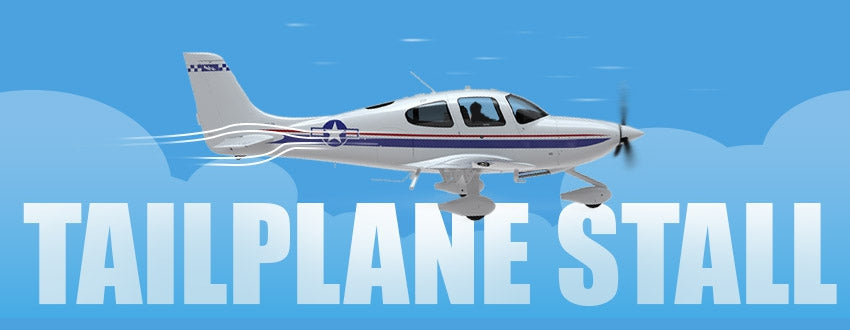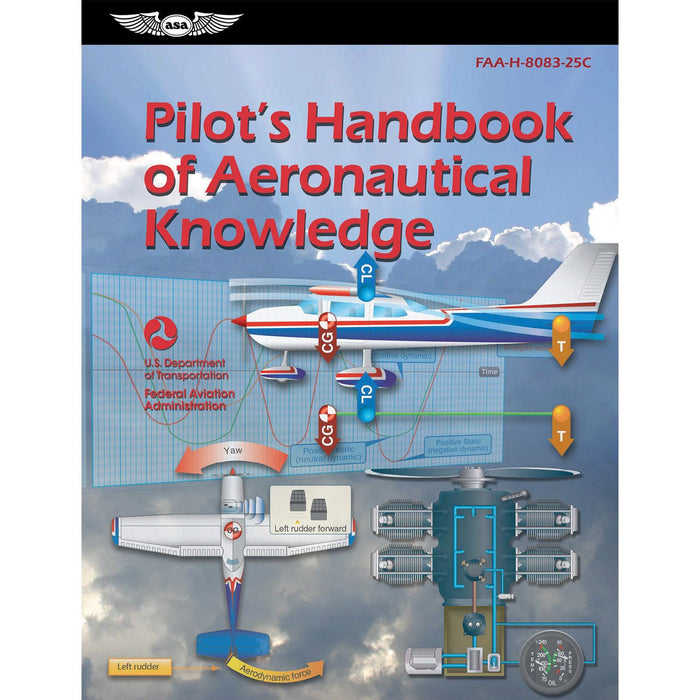Tailplane Stall: The Aerodynamics & How You Can Recover
Usually when we talk about airplane stalls, we are referencing aerodynamic wing stalls. A lesser discussed and potentially more lethal type of aerodynamic stall is a tailplane stall. As a pilot, it’s important to understand the unique situations in play leading up to and during a tailplane stall so that you can successfully prevent, recognize, and recover from these dangerous types of stalls.

Featured Pilot Gear
Browse our selection of high-quality pilot supplies! Your purchase directly supports our small business and helps us continue sharing valuable aviation content.
Usually, when we talk about airplane stalls, we are referencing aerodynamic wing stalls. A lesser discussed and potentially more lethal type of aerodynamic stall is a tailplane stall.
As a pilot, it’s important to understand the unique situations in play leading up to and during a tailplane stall so that you can successfully prevent, recognize, and recover from these dangerous types of stalls.

What is a tailplane stall?
The tailplane, or horizontal stabilizer, is a smaller lifting surface found aft of the main wing, on the tail of many fixed wing aircraft.
Like the main wing, a tailplane is designed to operate with smooth airflow along its surface. When the airflow separates from the tailplane, this is referred to as a tailplane stall.
(3D"Plane"by osmosikum is licensed under Creative Commons Attribution)
What is so dangerous about a tailplane stall?
During flight training, you learned about power-on stalls, power-off stalls, cross-controlled stalls, spins, and accelerated maneuver stalls. You drilled on what causes them, how to prevent them, and what to do if they occur.
What is so different and more dangerous about the tailplane stall? The problem with a tailplane stall is that when your horizontal stabilizer stalls, it is a dramatic and nearly always fatal event.
Another problem with the tailplane stall is that there is no hands-on training and practice for tailplane stalls and recoveries as there is with wing stalls. Finally, aircraft stall warning systems are configured to warn pilots about main wing stalls. There is no warning horn to indicate a tailplane stall.
Instead you are left with the specter of a rare, dangerous, likely deadly event that you have no training or preparation to handle.
Although tailplane stalls are nearly always fatal…there is good news. Research and testing has been done to learn what causes most tailplane stalls and what you as a pilot can do to optimize your chances of correcting the stall.
Combination of factors that increases the risk of a tailplane stall
Until 1995, the causes of tailplane stalls were veiled in mystery. Few resources had been dedicated to investigating and studying the phenomenon, but that had all changed with the October 31, 1994 fatal crash of an ATR 72 commuter airliner. Due to the conditions surrounding the crash, the NTSB did some further research on tailplane stalls.
Based on historical data, the NTSB found that a tailplane stall was more likely to occur if the following flight characteristics were met:
- High wing aircraft
- Flying in icing conditions
- Flaps fully extended
In 1995, NASA and the Airline Pilots Association (ALPA) teamed up to conduct a test flight that recreated the NTSB set of conditions. NASA engineers outfitted their high-wing turboprop research plane – a Twin Otter – with a strip of material on the leading edge of the left tailplane. This material simulated a significant accumulation of ice.
The brave crazy volunteer crew took the aircraft to 6,000 feet, then began their descent with partial flaps. Flight characteristics were normal. Flaps were fully extended, and things got interesting.
As soon as the flaps were fully extended, the nose quickly pitched down and the aircraft began a near vertical plummet. The pilots fully retracted the flaps and applied 170-pounds of up elevator control. One thousand nail-biting feet later, the plane recovered from the stall.
The joint NASA and ALPA test flight provided valuable flight data. As they initially suspected, a tailplane stall was most likely to occur in a high wing aircraft flying in icing conditions with flaps fully extended.
Since then we have also learned that certain aircraft are more susceptible to tailplane stalls. If your aircraft’s POH warns against flying in icing conditions, that is a good indicator that your plane is more prone to tailplane stalls.
Another learning lesson was that not all ice is created equal. While any ice on the horizontal stabilizer is bad news, mixed ice is especially dangerous. A mixed ice formation isn’t smooth and formed to the shape of the tailplane. It is rougher and less aerodynamic, so it increases the tailplane stall speed.
What causes a tailplane stall?
We have mentioned that tailplane stalls tend to occur as the flaps are extended. To understand how flap extension triggers the stall, let’s go into the aerodynamics of a tailplane. An aircraft’s center of gravity, or pivot point is usually located forward of the center of lift.
This creases a nose-down tendency and forward pitching moment. The horizontal stabilizer is much like an upside-down wing. Its purpose is to provide a down-force that counters the nose down moment.
The greater the nose-down moment, the greater the required offsetting tailplane downforce needed. For the aircraft to maintain straight and level flight, the tailplane must by flying at a lower angle of attack than the wing.
By extending the flaps, you effectively shift the center of lift aft, increasing the nose down pitching moment. The tailplane’s angle of attack increases. If the tailplane is coated in ice, particularly mixed ice, this increased angle of attack may be enough to trigger a stall.
As the tailplane stops providing sufficient down-force, the aircraft’s nose pitches forward violently, and you enter a tailplane stall.
Warning signs of an imminent tailplane stall
The warning signs of a tailplane stall are:
- Increasing difficulty trimming the aircraft – need for unusually high amount of nose up trim
- Nose pitching down
- Elevator vibrating or oscillating
- Control wheel moving on its own
- Loss of elevator effectiveness
The use of autopilot may mask many of these warning signs, so it is recommended that you disengage autopilot when flying in conditions that put you at a higher risk of tailplane stall.
What is the difference between a wing stall and a tailplane stall?
The warning signs of wing stalls and tailplane stalls are similar. It takes keen pilot awareness to differentiate the subtle differences. For example, in a tailplane stall, you will feel the buffeting in the controls, whereas an impending wing stall typically creates airframe buffeting.
Naturally, you should also pay attention to situational factors. If you enter a stall immediately after extending flaps and your flight meets the common characteristics for tailplane stalls, you should have a high index of suspicion that you may be in a tailplane stall rather than a wing stall.
(3D"Plane"by osmosikum is licensed under Creative Commons Attribution)
How to recover from a tailplane stall
The aerodynamics of a tailplane stall differ from those of a wing stall. It is important to understand these differences because recovery procedures for a tailplane stall are otherwise counter-intuitive.
Think of your tailplane as an upside-down wing, and that will help remind you that the stall recovery procedures are opposite.
Consult your aircraft manufacturer and POH for specifics, however the general tailplane stall recovery steps are:
- Fully retract flaps
- Reduce power
- Pull up to raise the nose
- Activate the de-icing system if your aircraft has one
Take Aways
- Tailplane stalls are rarer and often more deadly than wing stalls.
- Most tailplane stalls occur on high wing airplanes with a design that is susceptible to tailplane stalls. These planes tend to be flying in icing conditions and have ice, especially mixed ice, built up on the leading edge of the stabilizer. The stall occurs during full flap extension.
- If you suspect you have entered a tailplane stall, remember that the recovery procedures are opposite of those for a wing stall.
- Although you are unlikely to find yourself in a tailplane stall, an awareness of the aerodynamics, warning signs and recovery procedures will improve your odds of stall recovery.

|
ASA Pilot's Handbook of Aeronautical KnowledgeProviding basic knowledge essential for all pilots, from beginning students through to the advanced certificates, this Federal Aviation Administration (FAA) publication introduces readers to the broad spectrum of knowledge required as they progress through pilot training. |
Want to learn more about stalls?
Check out these guides to help you get on your way to becoming a more proficient pilot!
Did you find this article helpful?
Do you think we missed anything important? Let us know in the comments below!




































1 comment
Why do you “reduce” power in a tailplane stall, vs increasing power (from icing on the horizontal stab)